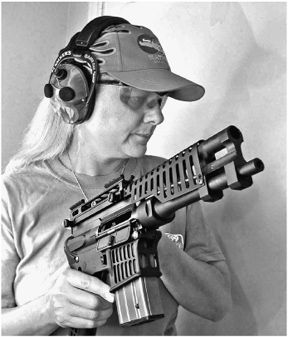
The versatile AR-15 rifle is available in a number of barrel lengths that variously define the weapon as a full-size rifle, more compact carbines, or bullpups. Even shorter, however, are the subjects of this test: AR-15 actions, devoid of shoulder stocks, fitted with barrels short enough to classify them legally as pistols.
The two “AR” pistols are the Olympic Arms OA 98, $1020, and Bushmaster’s $862 Carbon 15 Model 97. The Olympic Arms OA 98 is manufactured domestically in Olympia, Washington. The roots of Olympic Arms go back to the mid-1950s when the company was based in Colorado Springs and produced barrels under the name Schuetzen Gun Works. In 1975 the operation was moved to Olympia, where the manufacturing of AR-15 components under the name Olympic Arms began in 1982.
The design of the OA series of AR-15 type rifles connects to the OA 98 pistol. To accommodate a folding stock, Olympic Arms developed an upper that eliminated the need for a buffer tube. However, due to subsequent legal restrictions, folding-stock models such as the OA 93 and its cousins now feature fixed stocks, but these rifles still benefit from their minimal design and lighter weight. If you look at an OA-built AR-15 and imagine it without a stock, it is easy to visualize how the OA 98 pistol came into being.
Likewise, Bushmaster Firearms of Windham, Maine, produces a large selection of AR-15 based weapons. The model 97 appellations apply to three different Bushmaster weapons. The 97 rifle lacks sights but offers a flattop Picatinny rail. The 97S rifle comes with iron sights instead of a rail. If you are familiar with AR-15 rifles like these, you can visualize the 97 pistol by removing the forend, fitting a short 7.2-inch barrel, and deducting the buttstock, leaving only the buffer spring tube.
We fired most of our break-in and warm-up shots with remanufactured rounds from Georgia Arms, (770) 459-5117, that were reloaded using Winchester cases exclusively. We used this round for record as well. Also, we shot 60-grain V-Max cartridges from Black Hills Ammunition. This round featured a Hornady bullet with a polymer tip. These rounds looked factory new, but they shipped in the blue cardboard boxes (50-count) that told us they were remanufactured. (New Black Hills ammunition comes in a red box). Our third test round was the Power-Shok 55-grain soft point from Federal.
[PDFCAP(1)]
The OA 98’s frame was aluminum. Olympic Arms told us the grip was also fashioned from aluminum, but the one on our pistol looked more like polymer. To make the gun lighter, both the grip and the magazine housing were skeletonized. The grip did not look comfortable, and we saw shavings from the cuts. Nonetheless, when we handled the gun, we found comfort was not a problem, and we thought its design was effective. The heat shield that draped over the gas tube, recoil system, and barrel was relieved in the same manner as the magazine housing. The cuts in both areas gave the gun a distinctive appearance.
This model did not come with a case or with a magazine. In fact a manufacturer’s note on the website (olyarms.com) said that Olympic Arms is still negotiating with a supplier for a suitable case.
Chambering a round was accomplished via a charge bar accessible from the left side of the weapon. This bar offered a loose-floating fit and rode atop the weapon just below the scope mount. This arrangement made charging the weapon easy, but if you wished to lock back the bolt, a juggling act was required. Because the OA 98 could not be braced against the shoulder, locking back the bolt meant pulling the charge bar back with curled fingers of the left hand and holding the bolt rearward by placing the left thumb behind the end plate. Then the shooter had to reach over the top of the weapon with the right hand to set the bolt catch. The safety was similar to a standard AR-15 design, situated on the left side just above the grip.
There were no supplied sights on the OA 98, and the Picatinny rail was split into two sections. This rail would favor mounting a tube scope with rings front and back, but we chose a Bushnell Holosight electronic scope that included an integral mount. The Holosight was extremely rugged, very easy to zero, and the displayed reticule (a small dot in a circle) suffered from zero parallax. This meant the reticule did not have to appear centered in the scope to represent point of impact.
The last preparation we made for firing was to choose proper hearing protection. We would be conducting our tests outdoors, but from a covered bench with the aid of a sandbag rest. However, we found this gun to be very loud, even when fired in open spaces. For our safety and comfort, we opted for wearing earplugs and earmuffs. We used a pair of electronic muffs from Walker’s Game Ear, ($239, [800] 424-1069). Over the course of this test they protected our shooter’s hearing by gating out high-decibel noises, but amplified normal conversation as desired.
Given the sound and blast from the OA 98, how and when would this gun be used? We’re not sure. In the middle of the night a home-defense scenario without hearing protection would likely mean permanent hearing loss. Nighttime muzzle flash would also be significant. And we don’t think the 98 is the right gun for hunting, though the .223 cartridge is suitable for taking game. Thus, we had questions about what it would be used for, other than plinking.
Remembering that the OA 98 was not shipped with a magazine, we tried a variety of AR-15 magazines. The Bushmaster was shipped with a 10-round magazine with a green polymer follower, and we tested the OA 98 with this component as well as several surplus 20-round magazines and some English made 30-round models ordered from Dillon Precision, (800-223-4570) for $20. We found that neither gun digested any of the hollowpoint ammunition we tried, including the Winchester USA 45-grain JHP rounds. However, the OA 98 always cycled ball or softpoint ammunition.
The OA 98 did not come with open sights, [PDFCAP(2)] with the Bushnell Holosight in place. The most accurate round proved to be the Georgia Arms remanufactured loads. But we did notice that the point of impact on each target was significantly different. Standard deviation of this ammunition was much higher than our other two test rounds, and velocity was significantly lower, averaging below 2000 fps on our Oehler 35P chronograph ($345, Brownells, 800-741-0015). The Federal and Black Hills ammunitions both shot 1.4-inch five-shot average groups, but the Black Hills V-Max bullet traveled at nearly 2100 fps and produced much more muzzle velocity than the Federal rounds. With finer optics we think we could have achieved better accuracy with both of our guns.
In terms of reliability, the OA 98 continued to run without problem, and it never seemed to get dirty. It did collect a lot of scuff marks just behind the ejection port (from spent shells), but ejection did not seem to cause a problem for the shooter. In fact, we weren’t even aware of this until we got home from the range.
[PDFCAP(3)]
The Bushmaster Carbon 15 Model 97 featured a removable compensator, which was attached by a spring-loaded locking collar. We found this compensator to be very effective. Gases flowing through the ports were directed upward and did not cause a hazard to the left or right, and they did not stir up dust from the ground when we fired from the prone position. We liked the control, so we left the compensator in place.
To make up for the lack of a forend to grasp, the manufacturer’s description of the 97 at www.bushmaster.comadvised the shooter that the front of the magazine well did provide an alternate position for the weak hand. But most of our staff felt that this created too much push/pull for fine shooting. Besides, the Hogue rubber grip was comfortable enough for both hands. The Bushmaster 97 was shipped with one 10-round mag.
The 97 came with a set of open sights, consisting of a ring in the back and a ramp-style front sight blade. We felt this set up was too vague for serious accuracy. The top of the receiver offered a thin groove that would not accept any scope rings we could find, but was designed to fit a Picatinny rail found in the Bushmaster catalog. We paid $58 for the rail and carefully tapped it into place. The rail worked well with our Bushnell Holosight and sat tall enough so that we could still use the supplied open sights.
Placement of the magazine release and thumb safety was just above the grip, like on any AR-15 rifle. The letters “S” and “F” for Safe and Fire, respectively, were clearly marked. Operation of the thumb safety was left side only, but the right side of the frame clearly displayed the letters for Safe and Fire as well with a white line corresponding to the position of the safety to illustrate the condition of the weapon.
We charged the 97 with T-shaped bar. Without the gun shouldered, we found it easiest to pull the charge bar with the index and middle fingers, with the thumb pressing against the end of the buffer tube. This made setting the bolt catch on the model 97 less awkward than on the Olympic Arms OA 98 pistol, we believe.
Our first trip to the range was disappointing. We suffered several cycling problems, wherein there was a jam at the mouth of the chamber. Changing magazines or ammunition did not seem to alleviate the problem, so we put in a call to the manufacturer. Bushmaster immediately sent us a UPS return shipping label via email. Our 97 was returned within seven calendar days, and all seemed well. We proceeded with accuracy tests using only the open sights. Firing the Black Hills 60-grain V-Max rounds, our best groups averaged 2.3 inches. The Georgia Arms FMJ ammunition shot to an average of 2.6 inches. The Federal softpoint ammunition gave us our best results, with groups ranging from 1.7 to 2.4 inches. Firing with the scope in place, we averaged 1.6-inch groups with the Black Hills ammunition, 1.2 inches with the Federal rounds and 2.0 inches with loads from Georgia Arms. In two out of three cases, we found that using the Bushnell Holosight accounted for shrinking our five-shot groups about 1 inch.
But by the end of our test session, which consisted of about 350 rounds, our pistol began to malfunction again. This time, bullets were being pushed back into their cases when they hit the edge of the chamber before the bolt could fully close. We tried firing a variety of ammunition with a wide selection of magazines (10, 20, and 30 rounds), but the condition persisted. These magazines functioned in the Olympic Arms pistol, so we called Bushmaster. Bushmaster again issued a UPS label for return shipping, but this time to their senior gunsmith.
We returned our 97 pistol to Bushmaster for warranty work on July 19 via the UPS next-day sticker that we received about 24 hours after requesting service. Incidents of multiple feeds and bullets being pushed back into their cases due to impact with the feed ramp had already been reported. Our repaired pistol arrived at our door in nine calendar days.
Bushmaster listed the following on its repair invoice, for which there was no charge: “Exchanged gas block and extractor spring insert; Re-cut feed ramps.” The gun was test fired with an unspecified number of rounds and given an “ok.” We began shooting the gun again with the original 10-round magazine and found no problems firing the Georgia Arms ball ammunition (when holding the gun with a traditional two-handed pistol grip). Moving our weak hand to the magazine well immediately caused a failure to feed, wherein the next round was not picked up from the magazine. This also happened with an older 20-round magazine.
We are pretty sure the reason was that since we were partially holding on to the magazine, in addition to the magazine well, the upward movement of the gun upon recoil was pulling the magazine slightly out of position.
Also, new 30-round magazines worked fine in the Carbon 15 pistol. However, some of our older magazines that function in full-size AR-15 rifles gave the 97 troubles. This included double feeds and again, bullet mashing. We tried firing some 55-grain FMJ 5.56mm Winchester rounds (Q3131A), but experienced jams with that ammo, too.
Gun Tests Recommends
• Olympic Arms OA 98 .223 pistol, $1020. Buy It. The OA 98 may not fit into everyone’s plans for hunting or self defense, but we think it achieves what its manufacturer intended.
• Bushmaster Carbon 15 Model 97 .223 Pistol, $862. Don’t Buy. It was evident that Bushmaster’s service department was not aware this gun was being used in a test, so we’re reasonably sure other customers would get the same effort from customer service. In fact, we give Bushmaster an “A” for effort on that score. But it is our conclusion, based on the performance of our sample, that this gun is very picky about ammunition and magazines. As a result, we don’t feel comfortable recommending that you buy it.






























